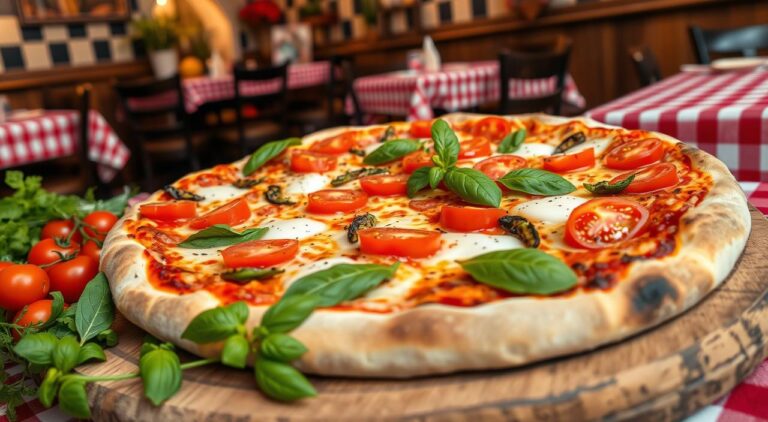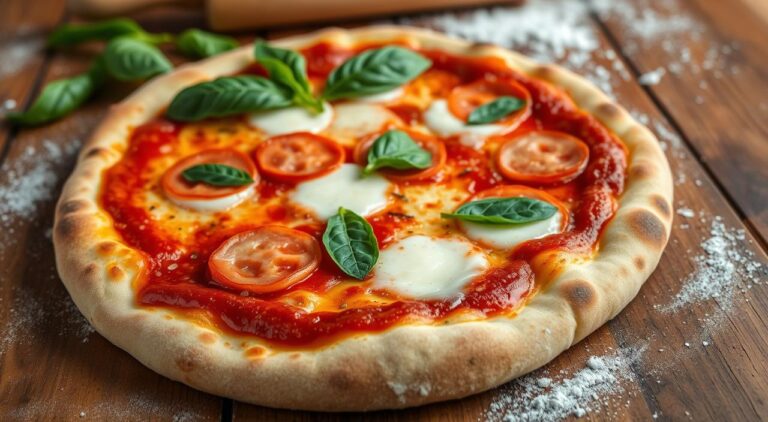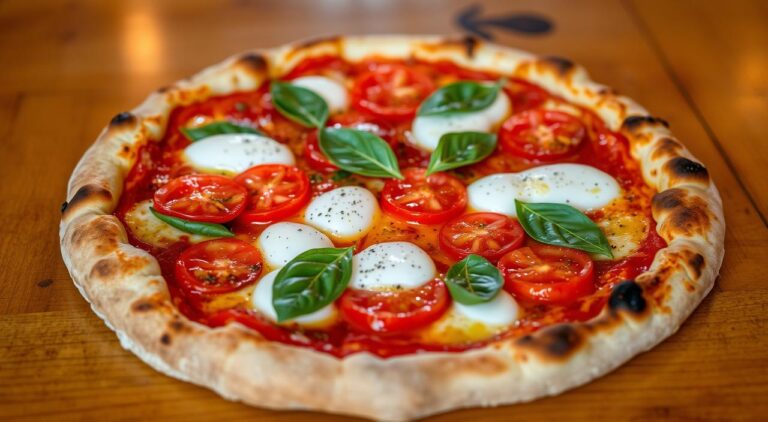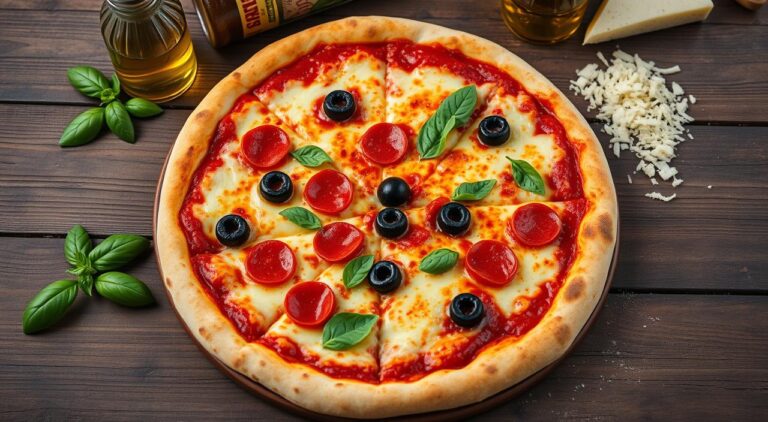Mafalda pasta is a ribbon-shaped noodle from Italy that has won the hearts of pasta lovers around the world. It comes from Italy’s rich food traditions. This pasta is special because of its unique shape and texture. It’s loved in both old and new Italian dishes.
Its story shows how Italian food has evolved over time. It’s a tale of tradition and new ideas coming together.
Key Takeaways
- Mafalda pasta is an iconic ribbon-shaped Italian noodle with a unique and captivating history.
- This semolina-based pasta offers a delightful texture and versatility, making it a beloved ingredient in both traditional and contemporary Italian dishes.
- Mafalda pasta’s elongated shape and characteristics set it apart from other pasta varieties, creating a distinct culinary experience.
- The popularity of mafalda pasta continues to rise, as it captures the essence of authentic Italian cuisine on a global scale.
- Embracing the traditional pasta shape of mafalda is crucial in preserving the authentic Italian culinary heritage.
Unveiling the Captivating History of Mafalda Pasta
The story of mafalda pasta goes back to Italy’s rich food traditions. It has always been a key part of Italian cuisine. The unique ribbon shape came from the need to match various sauces and toppings. Over time, mafalda pasta’s shape and how it’s made have changed, but its core has stayed true to Italian pasta making.
Origins and Evolution of this Iconic Pasta Shape
The story of ribbon-shaped pasta starts in the 14th century. Italian makers began trying out new shapes. Mafalda, a type of traditional Italian pasta shapes, came from these early experiments. The name “mafalda” comes from the Italian word “mafalde,” meaning the pasta looks like a medieval queen’s wavy hair.
Over the years, the origins of mafalda pasta and its evolution have been influenced by changing tastes and new pasta-making tech. Now, mafalda is a unique and loved pasta shape in the Italian culinary landscape.
“Mafalda pasta is a true testament to the enduring legacy of Italian pasta making, with its distinctive ribbon-like shape and rich history that spans centuries.”
Mafalda Pasta: A Semolina-Based Delicacy
Mafalda pasta is a treat for those who love pasta, made from top-quality semolina flour. This flour comes from the best durum wheat. It’s what makes mafalda pasta stand out in Italian cuisine.
The semolina flour gives mafalda its unique texture and a rich, slightly nutty taste. This pasta has a firm bite and a great feel in your mouth. It’s different from other Italian pastas. The semolina also helps it keep its shape while cooking, making every bite perfectly al dente.
Pasta made from semolina is highly valued in Italy for its quality and taste. The durum wheat pasta in mafalda shows Italy’s dedication to its pasta traditions. This semolina-based Italian pasta truly represents Italy’s rich food culture.
“Mafalda pasta is a true embodiment of the artistry and precision that goes into traditional Italian pasta-making. The semolina flour lends it a texture and flavor that is simply unforgettable.”
Enjoying mafalda in a classic Italian dish or trying new recipes, this semolina-based pasta will delight your taste buds. It takes you straight to the heart of Italy’s lively food scene.
The Versatility of Mafalda Pasta in Italian Cuisine
Mafalda pasta is known for its ribbon-like shape and semolina base. It’s a key ingredient in Italian cuisine. It pairs well with many sauces and toppings, from creamy to fresh. Mafalda pasta makes any meal special, whether it’s a classic dish or something new.
Classic and Contemporary Mafalda Pasta Recipes
Pasta al ragù is a classic dish that highlights versatile mafalda pasta. The pasta’s shape catches the rich flavors of the sauce perfectly. It makes for a delicious meal.
Mafalda pasta is not just for traditional dishes. It’s great for modern mafalda pasta dishes too. You can mix it with many flavors. Try it in salads with tomatoes and herbs, or in a cheesy bake with roasted veggies.
| Classic Mafalda Pasta Dishes | Contemporary Mafalda Pasta Recipes |
|---|---|
| Pasta al Ragù | Mafalda Pasta Salad with Tomatoes and Basil |
| Mafalda Pasta with Pesto | Baked Mafalda Pasta with Roasted Vegetables and Cheese |
| Mafalda Pasta Primavera | Mafalda Pasta with Lemon Garlic Shrimp |
“The versatility of mafalda pasta allows it to shine in a wide range of Italian dishes, from timeless classics to imaginative modern creations.”
Exploring the Unique Texture of Mafalda Pasta
Mafalda pasta is known for its special texture. It’s made from top-quality semolina. This gives it a unique feel that’s both firm and delicate. The pasta’s chewiness and nutty taste make eating it a special experience.
The way mafalda pasta is made is what makes it stand out. It’s made with semolina and has a ribbon shape. This makes it have a great consistency and a delightful bite.
When you mix it with tomato sauce or seafood, mafalda pasta really shines. It keeps its shape and bite, making it perfect for many Italian dishes.
| Pasta Characteristic | Mafalda Pasta | Typical Pasta |
|---|---|---|
| Texture | Firm yet delicate, with a subtle chewiness and nutty flavor | Varying levels of firmness and chewiness, depending on the type of pasta |
| Composition | Made from high-quality semolina | May be made from a variety of wheat flours or other grains |
| Shape | Ribbon-shaped, with a unique and visually appealing appearance | Wide range of shapes, from long strands to short, tubular forms |
Mafalda pasta’s texture shows the effort put into making it. It’s made with traditional methods and top ingredients. This makes it a favorite among pasta lovers worldwide.
“The texture of mafalda pasta is a true delight, offering a satisfying bite and a delicate, nutty flavor that perfectly complements a wide range of Italian sauces and dishes.”
Mafalda Pasta: The Elongated Cousin of Lasagna Noodles
Mafalda pasta and lasagna noodles look similar but are different. Mafalda is thinner and more delicate, with a ribbon-like shape. This makes it look elegant and refined. Its shape also changes how it works with sauces, making meals special.
Unlike lasagna noodles, mafalda pasta has a subtle texture. Its ribbon-shaped pasta varieties help sauces stick well. This makes it perfect for many Italian dishes, from casseroles to salads.
| Mafalda Pasta | Lasagna Noodles |
|---|---|
| Narrow, ribbon-like shape | Broad, flat shape |
| Delicate and refined texture | Hearty and substantial texture |
| Clings well to sauces and fillings | Holds up well in baked dishes |
| Versatile in various Italian dishes | Primarily used in lasagna and baked pasta dishes |
Mafalda pasta and lasagna noodles may look alike but are great for different dishes. Mafalda’s elegance makes it perfect for many Italian meals, from simple to complex.
The Art of Pairing Mafalda Pasta with Sauces
Mafalda pasta’s ribbon-like shape and semolina base make it great for many sauces. It goes well with light tomato sauces or rich Alfredo. This pasta enhances the taste of traditional Italian pasta sauces. Its shape helps spread sauce flavors evenly, making meals tasty and balanced.
Chefs love to mix mafalda pasta with ingredients that highlight its best qualities. This creates dishes that are both traditional and new. Mafalda pasta flavor pairings range from classic to adventurous, showing off this pasta’s versatility.
Complementary Flavors and Ingredients
Choosing the right sauces for mafalda pasta is key. Its ribbon texture is perfect with complementary ingredients for mafalda pasta, like:
- Fresh, ripe tomatoes for a light, summery sauce
- Creamy, cheesy sauces like Alfredo or carbonara
- Aromatic herbs and spices, such as basil, garlic, and red pepper flakes
- Rich, meaty sauces like Bolognese or braised lamb
- Sautéed vegetables and olive oil for a simple, yet flavorful dish
By trying different flavor combinations and complementary ingredients for mafalda pasta, cooks can bring out the best in this Italian pasta.
| Sauce | Flavor Profile | Recommended Mafalda Pasta Pairing |
|---|---|---|
| Tomato-based | Light, fresh, and vibrant | Mafalda pasta with its ribbon-like texture can perfectly capture the flavors of a classic tomato sauce. |
| Creamy Alfredo | Rich, indulgent, and comforting | The shape of mafalda pasta allows the creamy sauce to cling to the noodles, creating a harmonious balance of flavors. |
| Pesto | Fragrant, herbal, and nutty | The ribbon-like strands of mafalda pasta can effectively hold and distribute the bold flavors of a pesto sauce. |
Exploring different flavors and ingredients for mafalda pasta opens up new possibilities in cooking.
“The true joy of cooking with mafalda pasta lies in the endless possibilities of flavor combinations. Its unique shape and texture allow it to serve as a canvas for culinary exploration.”
Mafalda Pasta: A Durum Wheat Delight
At the core of mafalda pasta’s greatness is its main ingredient: durum wheat. This top-notch grain is famous for its high protein and golden color. It’s a key part of many Italian pasta types, like the loved mafalda. The durum wheat in mafalda is turned into semolina flour. This flour is then shaped into the unique noodles that make mafalda stand out.
Durum wheat is a key feature of top-notch Italian pasta. It keeps mafalda tasting like true traditional Italian pasta ingredients. This focus on quality and tradition makes mafalda a favorite among pasta lovers.
| Nutrient | Durum Wheat | All-Purpose Flour |
|---|---|---|
| Protein | 12-14g per 100g | 8-11g per 100g |
| Gluten Content | High | Moderate |
| Color | Golden Yellow | Pale White |
The table shows the main differences between durum wheat and all-purpose flour. It points out why durum wheat is the top choice for making high-quality Italian pasta like mafalda.
“The use of durum wheat is a hallmark of authentic Italian pasta-making, ensuring that mafalda maintains the signature taste and texture that pasta enthusiasts crave.”
Embracing the Traditional Pasta Shape of Mafalda
The ribbon-like shape of mafalda pasta shows the lasting traditions of traditional Italian pasta shapes. This unique shape has been kept alive through generations. Skilled artisans work hard to keep the true production methods and quality of this pasta.
By choosing the traditional shape of mafalda, we honor the deep roots of Italian cuisine. This choice gives diners a real authentic Italian pasta experience. It keeps the unique character of mafalda pasta alive in our culinary world.
Preserving the Authentic Italian Culinary Experience
The popularity of traditional Italian pasta shapes is growing. It’s vital to keep the essence of iconic shapes like mafalda alive. By using the ribbon-like form of this pasta, chefs and cooks can make dishes that truly show the spirit of authentic Italian cuisine.
“The shape of mafalda pasta is not just a visual delight; it’s a connection to the rich tapestry of Italian culinary history.”
Keeping the traditional shape of mafalda shows the commitment of Italian pasta makers. They have perfected this craft over centuries. By valuing these traditional Italian pasta shapes, we help keep the authentic Italian pasta experience alive for food lovers everywhere.
Mafalda Pasta: The Narrow Ribbon-Shaped Noodles
Mafalda pasta is a delightful Italian treat, known for its unique ribbon-like shape. These elongated pasta varieties are made from top-quality semolina flour. This gives them a special texture and look that makes them stand out in Italian cuisine. The ribbon-shaped pasta makes these mafalda pasta noodles easy to mix into many dishes, from classic sauces to new recipes.
The narrow pasta ribbons of mafalda pasta add a delicate touch to any dish. Their shape lets them blend well with different sauces and ingredients. This makes mafalda a favorite in Italian cooking. Whether it’s with a classic tomato sauce or something more adventurous, these elongated pasta varieties make meals more exciting with their beautiful look and great taste.
Mafalda pasta’s unique shape and feel come from a long tradition of Italian cooking. These narrow pasta ribbons honor Italy’s pasta-making history. At the same time, they bring a fresh and creative twist to traditional Italian flavors. As more people discover mafalda pasta noodles, these ribbon-shaped pasta treats are set to stay a beloved part of Italian food.
The Rise of Mafalda Noodles in Global Cuisine
The love for authentic Italian food is growing worldwide. This has made mafalda pasta more popular. People everywhere are enjoying its unique shape and taste.
Now, mafalda noodles are found in many dishes. They bring together the flavors and traditions of Italian food. This shows how Italian cuisine is loved globally.
Today, mafalda noodles are a hit in kitchens and restaurants everywhere. They are used in new takes on classic Italian dishes and in fusion foods. This shows how versatile and special mafalda noodles are.
The popularity of mafalda noodles in global cuisine shows the lasting appeal of Italian pasta. As more people discover Italian food, mafalda pasta is becoming a favorite. It’s a symbol of Italy’s rich food culture.
“The rise of mafalda noodles in global cuisine is a testament to the enduring allure of Italy’s culinary legacy and the ability of its iconic ingredients to transcend borders and captivate palates worldwide.”
Conclusion: Celebrating the Ribbon-Shaped Italian Delight
The story of mafalda pasta shows how it’s a key part of Italy’s rich food culture. It’s made from semolina and has become popular around the world. This Italian pasta is a favorite in the world of traditional Italian cuisine.
People love mafalda pasta for its quality and the care put into making it. It’s used in many classic dishes and new ones too. The unique shape and taste of mafalda win over pasta fans everywhere.
As we end our look at mafalda pasta, let’s praise its lasting impact. We honor the makers who keep its true taste alive. By enjoying and celebrating mafalda pasta, we connect more with Italian culinary traditions. These traditions inspire and make us happy.










